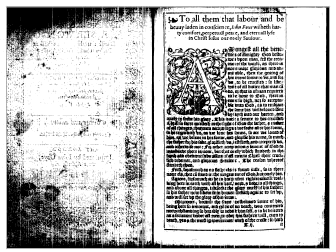
S_11242.6 (A sermon of Christ - image 1)

Q. Please confirm if it is acceptable to key <gap desc="damage"> for the first image of this document which should be the title page. Also, the first 4 images of this title have many illegible characters. Please note that we will use illegible defaults as necessary for every occurrence of illegible data.
A. The first page that appears in this document is, I think, the blank *back* of the title page. The faint marks that appear there seem to be bleedthrough from the front. The title page itself (i.e., the front of the title page) is missing completely. In a case like this, I would not use a gap, since the gap would have to appear on a page that is not there in the image, and we're only guessing as to what would have been on it in any case. I think I'd just do this:
<FRONT>
<DIV1 TYPE="epistle dedicatory">
<PB REF="1"> [this is for the blank page]
<PB REF="2">
<OPENER>To all them that labour and be heauy
laden in conscience, <HI>Iohn Foxe</HI> wisheth
har|ty comfort, perpetuall peace, and eternall
lyfe in Christ Iesus our onely Sauiour.</OPENER>
<P>AMongest all the bene|fittes of almighty God
...
The larger question, to my mind, is whether this book is legible enough to be worth converting at all. I would remind you that if more than one word in ten (or thereabouts: the number is arbitrary and should perhaps be higher) ends up difficult enough to justify a "$" mark, then you are encouraged to reject the whole book and move on to one that rewards your labors better. I've only looked ahead a few pages in this one, but it doesn't look very promising. In many cases, including this one, there may be better editions or copies available that we can substitute.
W_H2665 (Amanda, a sacrifice to an unknown goddesse - image 53 and 52)
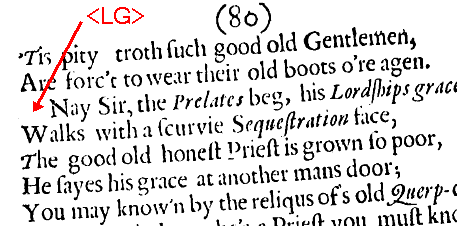
Q. Is it acceptable to treat the indented lines as the start of <LG>s?
A. Yes. These look like minimally marked verse paragraphs, which are aptly treated as <LG>s. Since they're not very emphatically marked, in review we would probably not bother to insert <LG>s if you left them out, but neither would we remove them if you put them in.
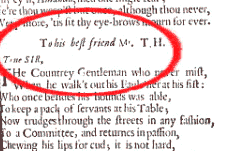
Q. How do we treat the data that seems to be an opener "True Sir,"
of a letter?
A. I'd treat it as an <OPENER>:<DIV1 TYPE="poem">
<HEAD>To his best friend Mr. T. H.</HEAD>
<OPENER>True SIR,</OPENER>
<LG>
<L>
W_H2620 (Micrographia - image 184)
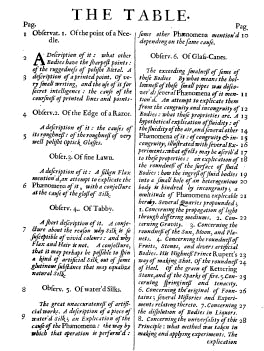
Q. A table appeared at the back matter of the document which seems to be the table of contents. Could we just treat this as LIST? If so, how should we capture the page number as it's appearance and position looks like a milestone? Are we correct to capture it in this way;
<div1 type="table">
<hd>THE TABLE</hd>
<list>
<label>1 2 3</label>
<item>Observant.1. Of the point of a Needle.
<p>A Description of it: what other Bodies
have the sharpest
points....</p></item>
<label>4 5</label>
<item>Observ.2. Of the Edge of a Razor.
<p>A description of it: the causes of its....</p></item>
Otherwise, please advise.
A. Given the limited tag set that we have made available, I see no really good way to tag this thing. Your suggestion of <LIST> makes sense in that it forces it into the model of tables of contents. To my mind, however, this solution fails to account adequately for the difference between the headings ("Observ.2. Of the Edge of a Razor") and the prose summaries, since <HEAD> is not allowed within <ITEM>. Though it is not quite appropriate, the easiest way to deal with this, I think, is to use the <MILESTONE> tag to deal with the marginal numbers, inserting them into the text using the rules for <NOTE>s: that is, since they are not explicitly linked to any particular point, place them after the nearest end-of-sentence punctuation.
<BACK>
<DIV1 TYPE="table">
<HEAD>THE TABLE.</HEAD>
<DIV2 TYPE="item">
<HEAD>Observat. 1. Of the point of a Nee|dle.
<MILESTONE UNIT="page" N="1"></HEAD>
<P>A Description of it: what other Bodies have the
sharpest points: of the ruggedness of polisht Metal.
<MILESTONE UNIT="page" N="2"> A description of a
printed point.<MILESTONE UNIT="page" N="3"> Of
ve|ry small writing, and the use of it for
secret intelligence: the cause of the coursness of
printed lines and points.</P></DIV2>
<DIV2 TYPE="item">
<HEAD>Of the Edge of a Razor.
<MILESTONE UNIT="page" N="4"></HEAD>
<P>A description of it: the causes of its roughness:
of the roughness of very well polisht Optick Glasses.
<MILESTONE UNIT="page" N="5"></P></DIV2>
S_13735 (The soules preparation for Christ - image 4)
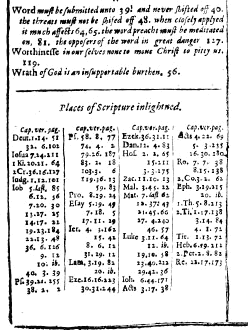
Q. Please confirm if it is OK to capture the text on as three (3) columns
table with Cap., ver., and pag. headings.
A. Yes, this is ok--but it would also be ok (and easier) simply to record it as a list, since that is closer to its actual appearance in the book, and the periods (.) serve to separate the numbers for chapter, verse, and page in any case.
<LIST>
<ITEM>Deut.1.14.51</ITEM>
<ITEM>32.6.202</ITEM>
<ITEM>Iosua 7.14.211</ITEM>
<ITEM>1 Ki. 20.21.64</ITEM>
<ITEM>2 Cr. 36.16.127</ITEM>
<ITEM>Iudg. 1.12.101</ITEM>
...
S_7226 (Poly-Olbion - image 99)
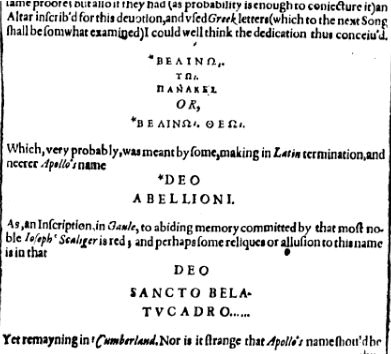
Q. Encountered names appeared on the center of text flow, followed by a paragraph for each name. Would it be fine to tag each name as <p>? Otherwise, please advise the proper tagging.
A. I think I'd treat these as block quotes, just like the material on the next page, using the <Q> tag (I've omitted two of the marginal notes, to make this easier to read):
<P> ... Which, very probably, was meant by some, making in
<HI>Latin</HI> termination, and neerer <HI>Apollo's</HI>
name
<Q><NOTE N="*">To God <HI>A|bellio.</HI></NOTE>
DEO ABELLIONI.</Q>
As, an Inscription, in <HI>Gaule,</HI> to abiding memory
committed by that most noble <HI>Ioseph Scaliger</HI> is red,
and perhaps some reliques or allusion to this name is in
that
<Q>DEO SANCTO BELA|TVCADRO...</Q>
Yet remayning in <HI>Cumberland.</HI> Nor is it
strange ... </P>
W_B3998 (New experiment physico - image 159)
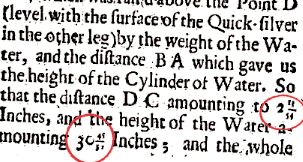
Q. Fractions appeared within the text. Are we correct to separate the numbers in fraction with slash "/"? Example: 2 13/54, 30 45/53
A. Yes. Excellent!
W_R186A (Sir Walter Raleigh's Sceptick - images 7 & 8)
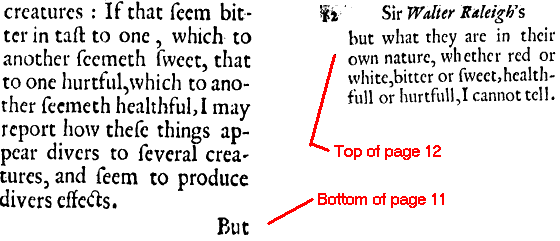
Q. If you will notice on the flow of text, there could be a missing page
in this book. Do we capture it as shown as the sequence of the actual page number
of the book? If so, on actual page 12, are we correct to start a new paragraph
<p>? Please advise.
A. There does not seem to be any text missing. The page numbers are sequential, and the sense is uninterrupted. It's just that when the printer closed the one page, he expected to start a new paragraph on the next; when he printed the next, he forgot that and printed it as continuous text. As to whether you should insert a <P> tag in that circumstance, it really doesn't matter. I wouldn't, but the matter is a trivial one.
S_23728 (An arrant thiefe - images 16 & 17)

Q. a. Another book that seems to be missing pages. Please confirm if we will just capture it as shown.
A. I think the catchword is wrong, but that there is no actual missing text. So capture it as it appears.
b. Also, we noticed that on the book folds (on the middle of the book
see same images attached) every word is illegible. Would be OK to replace the
illegible character(s) with "@"? Please advise.
A. Yes. Or "$" (which is going to be our single "bad-text" flag in future.